The fight to save Kolkata's heritage homes
- Published
Author Amit Chaudhuri explains why Kolkata's heritage homes are so special
Kolkata's historic homes reflect a rich architectural heritage - where European styles are blended with mix of colonial and Indian influences. But they are now under threat, as Divya Guha reports.
I'm standing on the roof terrace of a 150-year-old bungalow in India's eastern city of Kolkata (formerly Calcutta): a rambling establishment, beautiful but unkempt and sadly disintegrating in places.
This home in the Shyambazar neighbourhood could well be an example of a building that well-known author Amit Chaudhuri is trying to save from heedless destruction at the hands of the city's land developers.
In a letter Mr Chaudhuri wrote to authorities, which initiated a campaign to save Kolkata's rich architectural inheritance, he said such buildings "palpably contain" the city's rich architectural heritage and ethos.
Mr Chaudhuri, who has written frequently about the city in his essays, and in his book A Strange and Sublime Address, has found himself at the helm of a campaign to conserve his city's architectural heritage.
More than 2,300 people have signed his petition, external to the authorities, and he wrote a widely shared piece in The Guardian, external on the subject. Nobel Laureate Amartya Sen, poet and writer Ketaki Kushari Dyson, and novelist Rana Dasgupta, are among those who have pledged support.

Writer Amit Chaudhuri is leading a campaign to save the old houses of Kolkata
Back at the Shyambazar house, Neeta Sur, who has lived here since she was born, says the house was bought by her great-great-grandfather who ran a successful paper business in the mid-1800s.
His riches grew, she says, as he later took over the distributorship of British publishers Macmillan. A sole distributorship, the premium, says Ms Sur, made the business very profitable.
She says her great-grandfather, Motilal Sur, however, drained the family coffers, patronising the famous Star Theatre which at the turn of the last century was a vibrant stage for popular Bengali drama, and is now run as a cinema.
Ms Sur recounts these stories fondly but is dismayed by the neglect her home has suffered.
"Had you seen this house even 25 years ago, you'd see how glorious it was. Six months of the year there would be masons, painters and carpenters doing the rounds here. I recall pieces of furniture being sandpapered and polished and re-polished."
"Today's generation lacks the ability to share space... They prefer to exchange their beautiful homes for apartments and call it 'progress'."

The old buildings of Kolkata
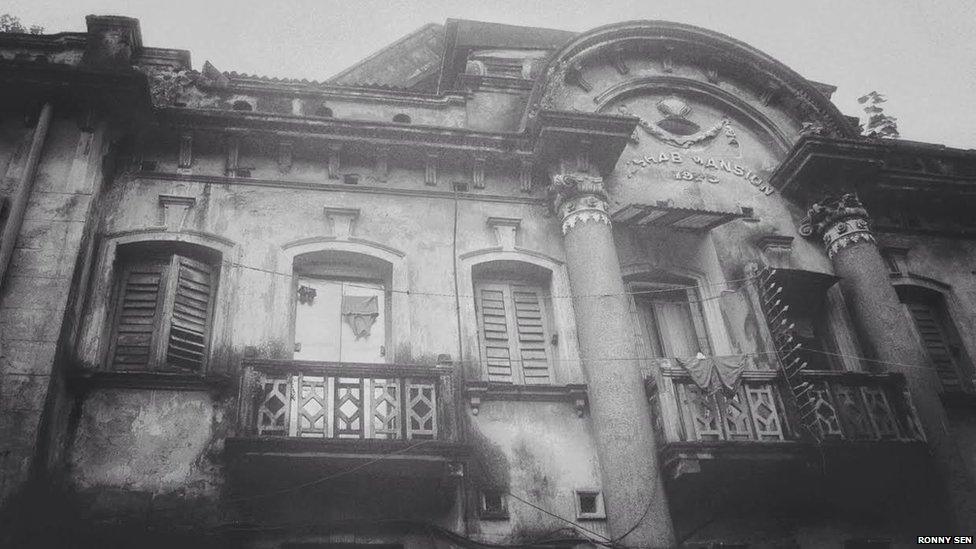
The city's old buildings reflect diverse architectural styles
Many of Kolkata's old buildings reflect diverse European architectural styles that in time became imbued with Bengali and Marwari (or classical Rajasthani) influences, creating a unique blend of Indo-European design, unique to the city.
The facades of no two buildings look the same in its densely built neighbourhoods, with rows of buildings constructed as per rules laid down by the city's municipality.
The old contractors and architects believed in building elegantly: ornamental entrances; large embellished "windows" in the French style which doubled up as doors, and lofty ceilings designed for Kolkata's expansive heat and damp.
Along with airy verandas edged with ornamental pillars, there were courtyards on the first and ground floors, and ledges, grilles and awnings which kept the glare of the sun and the rain away. There are plenty of spots for repose, or adda - the free flow of political ideas.

Many who inherited these homes are tempted to sell their land to property sharks who promise free flats to them as bonuses.
Sadly, the sale of an old property to a land developer means its immediate demolition, and scores of homes in Kolkata are being demolished each week to be replaced by dull cookie-cutter builders' flats.
Owners are aware of the historic value of their homes, but many say they are right to want to move - who would not get sick of ageing plumbing and stubbornly leaky roofs?
"There are a whole lot of people who are inured to this destruction," said Amit Chaudhuri. "Or see it as either an inevitability or a necessity."
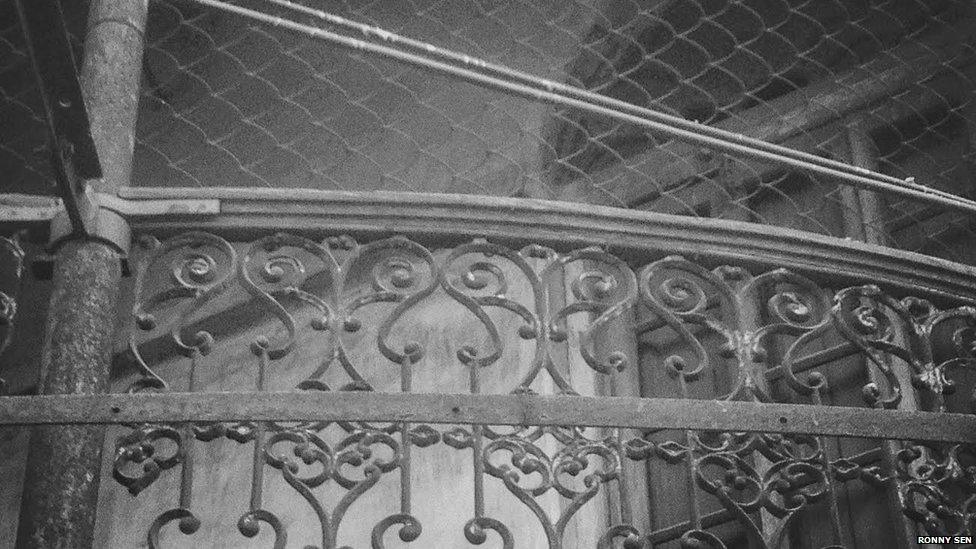
A curved balcony is a distinguishing feature of a well-known old house
The terrace of Ms Sur's house provides a surprisingly calming view of the city that contrasts sharply with the crowds three floors below.
The building has wings that radiate in all directions, several roofs connected by terraces at split levels by precarious looking mini concrete bridges, some parts invaded by moss, others fenced off by crumbling waist-high terracotta banisters shaped like urns.

Many who inherited these homes are tempted to sell their land to property sharks
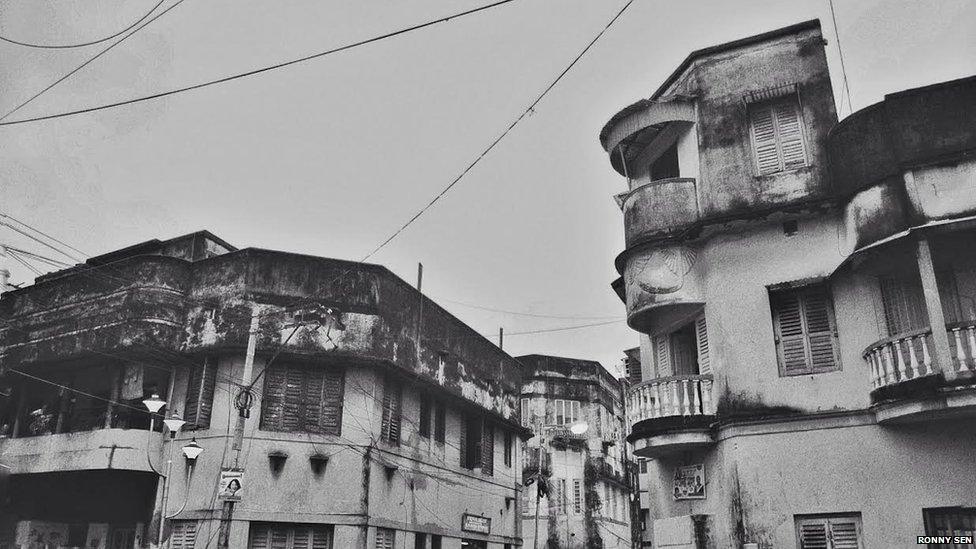
Mr Chaudhuri says his campaign will make help residents to 'look at these buildings again'
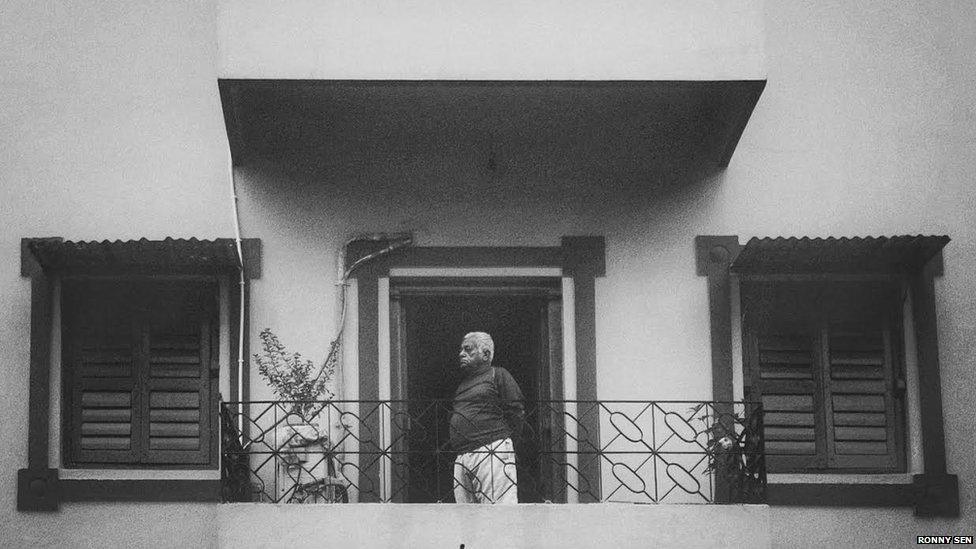
Owners are aware of the historic value of their homes, but many say they are right to want to move
There is a defunct neo-Gothic clock tower over the road with a tree sprouting out of its spire against Kolkata's muddy grey sky.
Inside, the furniture is of solid oak, teak and marble, there are vintage black and white tile and red oxide floors, all over the house there are wooden cupboards full of old crystal and china, and interesting bric-a-brac.
Though things look dusty and disregarded, they are nearly all collectible, and Ms Sur knows this well.
I'm shown to nearby Golbari - which literally means "round house" - a well known landmark in the city, also owned by Ms Sur's family.
Here, a puzzlingly narrow entrance and staircase lead to a capacious property of three floors piled with moth-eaten books, no doubt from the family's Macmillan days.
I have a dusting of cobwebs on me as I walk around the old drawing room.
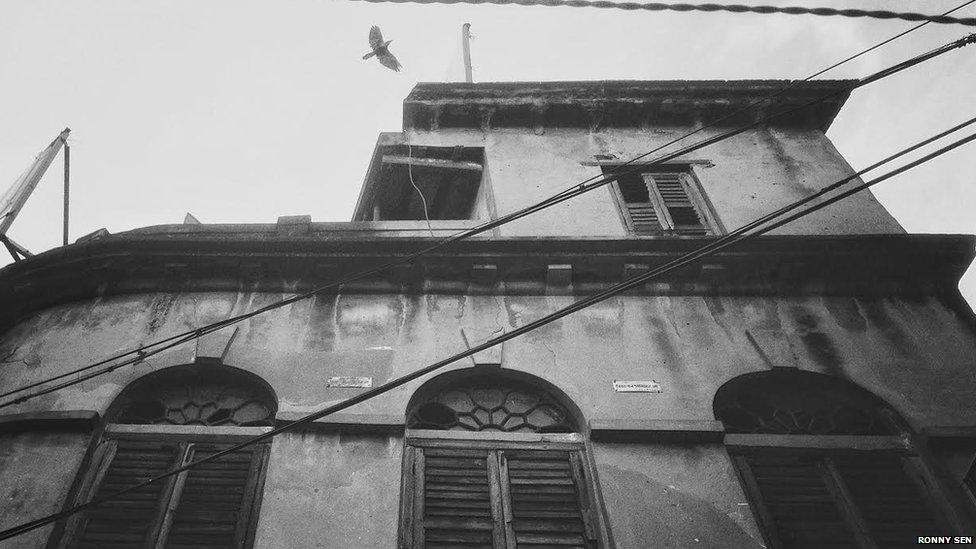
The Golbari - 'round house' - is a well known landmark in Kolkata
The fascinating feature of this house is a curved balcony that gives this building its name. It is bordered with slender iron pillars and grilles connected with latticed arches of lace-like cast iron filigree to reduce glare.
It offers a grand view of Shyambazar's five-point crossing with tramways, initially horse-drawn, then replaced by an electrified system in the early 1900s, which still runs - or crawls - today.
Now, Ms Sur complains, the view from the balcony is obstructed by a large billboard advertising cotton vests for men, that has been mounted on top of a boxlike Kolkata Police enclosure.
'Lack of vision'
It is this blindness to its own beauty that Mr Chaudhuri hopes to reverse.
He says the campaign will make us "look at these buildings again - something we've stopped doing for a number of reasons".
Meanwhile, city planners and policymakers continue to take the easy way out, he says. "The reasons for their indifference are clear."
"It's related to short-term gains via development, and a refusal to engage with the hard work needed for urban regeneration. Most often it has to do with a lack of vision."
Divya Guha is an independent journalist. Video shot by Ronny Sen, music by Tajdar Junaid